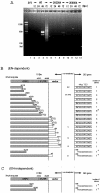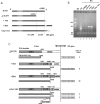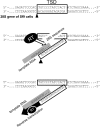Functional roles of 3'-terminal structures of template RNA during in vivo retrotransposition of non-LTR retrotransposon, R1Bm
- PMID: 15814816
- PMCID: PMC1074724
- DOI: 10.1093/nar/gki347
Functional roles of 3'-terminal structures of template RNA during in vivo retrotransposition of non-LTR retrotransposon, R1Bm
Abstract
R1Bm is a non-LTR retrotransposon found specifically within 28S rRNA genes of the silkworm. Different from other non-LTR retrotransposons encoding two open reading frames (ORFs), R1Bm structurally lacks a poly (A) tract at its 3' end. To study how R1Bm initiates reverse transcription from the poly (A)-less template RNA, we established an in vivo retrotransposition system using recombinant baculovirus, and characterized retrotransposition activities of R1Bm. Target-primed reverse transcription (TPRT) of R1Bm occurred from the cleavage site generated by endonuclease (EN). The 147 bp of 3'-untranslated region (3'UTR) was essential for efficient retrotransposition of R1Bm. Even using the complete R1Bm element, however, reverse transcription started from various sites of the template RNA mostly with 5'-UG-3' or 5'-UGU-3' at their 3' ends, which are presumably base-paired with 3' end of the EN-digested 28S rDNA target sequence, 5'-AGTAGATAGGGACA-3'. When the downstream sequence of 28S rDNA target was added to the 3' end of R1 unit, reverse transcription started exactly from the 3' end of 3'UTR and retrotransposition efficiency increased. These results indicate that 3'-terminal structure of template RNA including read-through region interacts with its target rDNA sequences of R1Bm, which plays important roles in initial process of TPRT in vivo.
Figures






Similar articles
-
Essential motifs in the 3' untranslated region required for retrotransposition and the precise start of reverse transcription in non-long-terminal-repeat retrotransposon SART1.Mol Cell Biol. 2004 Sep;24(18):7902-13. doi: 10.1128/MCB.24.18.7902-7913.2004. Mol Cell Biol. 2004. PMID: 15340053 Free PMC article.
-
R5 retrotransposons insert into a family of infrequently transcribed 28S rRNA genes of planaria.Mol Biol Evol. 2003 Aug;20(8):1260-70. doi: 10.1093/molbev/msg141. Epub 2003 May 30. Mol Biol Evol. 2003. PMID: 12777502
-
Footprint of the retrotransposon R2Bm protein on its target site before and after cleavage.J Mol Biol. 2004 Mar 5;336(5):1035-45. doi: 10.1016/j.jmb.2003.12.077. J Mol Biol. 2004. PMID: 15037067
-
Integration, Regulation, and Long-Term Stability of R2 Retrotransposons.Microbiol Spectr. 2015 Apr;3(2):MDNA3-0011-2014. doi: 10.1128/microbiolspec.MDNA3-0011-2014. Microbiol Spectr. 2015. PMID: 26104703 Free PMC article. Review.
-
Site-specific non-LTR retrotransposons.Microbiol Spectr. 2015 Apr;3(2):MDNA3-0001-2014. doi: 10.1128/microbiolspec.MDNA3-0001-2014. Microbiol Spectr. 2015. PMID: 26104700 Review.
Cited by
-
R2 and R2/R1 hybrid non-autonomous retrotransposons derived by internal deletions of full-length elements.Mob DNA. 2012 May 23;3(1):10. doi: 10.1186/1759-8753-3-10. Mob DNA. 2012. PMID: 22621441 Free PMC article.
-
Telomere-specific non-LTR retrotransposons and telomere maintenance in the silkworm, Bombyx mori.Chromosome Res. 2005;13(5):455-67. doi: 10.1007/s10577-005-0990-9. Chromosome Res. 2005. PMID: 16132811 Review.
-
Targeted gene knockin in zebrafish using the 28S rDNA-specific non-LTR-retrotransposon R2Ol.Mob DNA. 2019 May 22;10:23. doi: 10.1186/s13100-019-0167-2. eCollection 2019. Mob DNA. 2019. PMID: 31139267 Free PMC article.
-
Interaction between Bombyx mori Cytoplasmic Polyhedrosis Virus NSP8 and BmAgo2 Inhibits RNA Interference and Enhances Virus Proliferation.Microbiol Spectr. 2023 Aug 17;11(4):e0493822. doi: 10.1128/spectrum.04938-22. Epub 2023 Jun 21. Microbiol Spectr. 2023. PMID: 37341621 Free PMC article.
-
The diversity of retrotransposons and the properties of their reverse transcriptases.Virus Res. 2008 Jun;134(1-2):221-34. doi: 10.1016/j.virusres.2007.12.010. Epub 2008 Feb 7. Virus Res. 2008. PMID: 18261821 Free PMC article. Review.
References
-
- Lander E.S., Linton L.M., Birren B., Nusbaum C., Zody M.C., Baldwin J., Devon K., Dewar K., Doyle M., FitzHugh W., et al. Initial sequencing and analysis of the human genome. Nature. 2001;409:860–921. - PubMed
-
- Moran J.V., DeBerardinis R.J., Kazazian H.H., Jr Exon shuffling by L1 retrotransposition. Science. 1999;283:1530–1534. - PubMed
-
- Gilbert N., Lutz-Prigge S., Moran J.V. Genomic deletions created upon LINE-1 retrotransposition. Cell. 2002;110:315–325. - PubMed
-
- Symer D.E., Connelly C., Szak S.T., Caputo E.M., Cost G.J., Parmigiani G., Boeke J.D. Human L1 retrotransposition is associated with genetic instability in vivo. Cell. 2002;110:327–338. - PubMed
Publication types
MeSH terms
Substances
LinkOut - more resources
Full Text Sources
Research Materials

